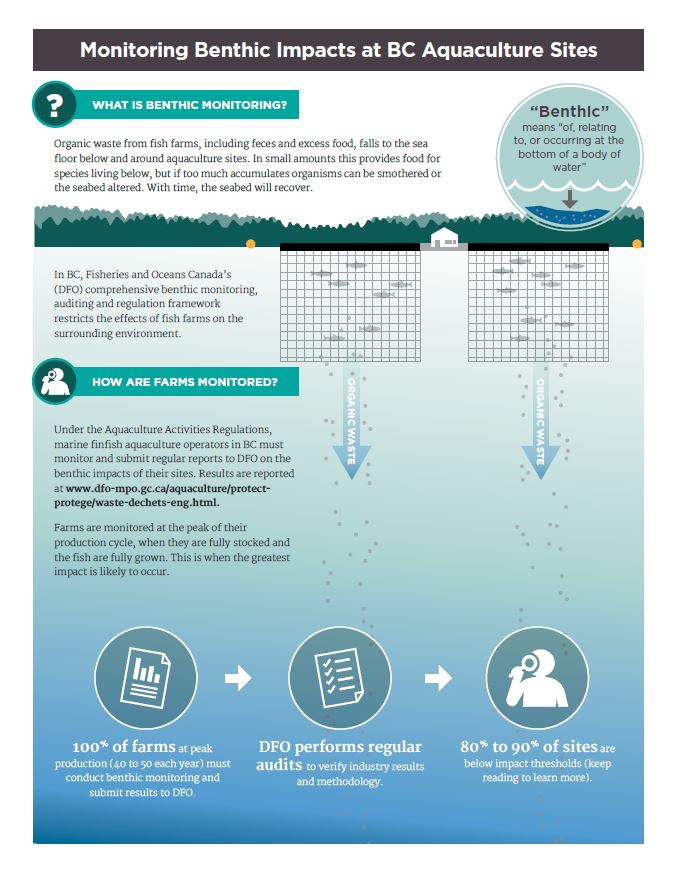Monitoring benthic impacts at BC aquaculture sites

Description: Monitoring benthic impacts at BC aquaculture sites
What is benthic monitoring
Organic waste from fish farms, including feces and excess food, falls to the sea floor below and around aquaculture sites. In small amounts this provides food for species living below, but if too much accumulates organisms can be smothered or the seabed altered. With time, the seabed will recover.
In BC, Fisheries and Oceans Canada's (DFO) comprehensive benthic monitoring, auditing and regulation framework restricts the effects of fish farms on the surrounding environment.
“Benthic” means “of, relating to, or occurring at the bottom of a body of water”
How are farms monitored
Under the Aquaculture Activities Regulations, marine finfish aquaculture operators in BC must monitor and submit regular reports to DFO on the benthic impacts of their sites. Results are reported at Managing organic wastes.
Farms are monitored at the peak of their production cycle, when they are fully stocked and the fish are fully grown. This is when the greatest impact is likely to occur.
- 100% of farms at peak production (40 to 50 each year) must conduct benthic monitoring and submit results to DFO
- DFO performs regular audits to verify industry results and methodology
- 80% to 90% of sites are below impact thresholds (keep reading to learn more)
Soft or hard bottom
Benthic monitoring activities depend on the nature of the sea floor beneath the farm. In BC, the sea floor is generally defined as soft bottom or hard bottom.
These are the benthic monitoring procedures that industry must follow. DFO biologists follow these same procedures during benthic audits.
Soft-bottom sites
- A sampling device is used to scoop up mud, clay or sand sediments
- Sediment samples are taken at 30 and 125 metres from both sides of the cage edge
- Samples are brought to the surface and analyzed for their level of free sulphides. A healthy seabed with plenty of oxygen will have low levels of sulphides
- At 30m stations, the threshold is 1300µmol free sulphides
- At 125m stations, the threshold is 700µmol of free sulphides
Hard-bottom sites
- Underwater cameras take video of gravel, boulder or bedrock seabeds
- The video is reviewed in-office for presence of Beggiatoa and opportunistic polychaete complexes (OPCs)
- Beggiatoa are bacteria that form visible white mats. OPCs are organisms that look like orange shag carpeting
- These species can survive where others can't and help break down accumulated waste. Their presence is also an indicator of elevated sulphide levels
- Video of the area from 100 to 124 metres from the cage edge is assessed for impact
- This area is broken into 6 segments. If more than 4 have more than 10% cover of Beggiatoa or OPC, the threshold has been exceeded
If thresholds are exceeded, the site cannot be restocked with fish until further monitoring shows that sufficient recovery has occurred.
DFO's regulation and monitoring of aquaculture in BC supports an environmentally sustainable industry that helps remove pressure from wild salmon stocks.
- Date modified: